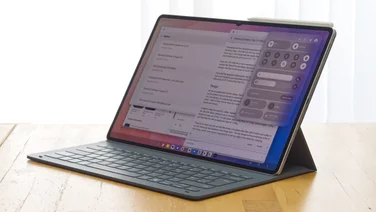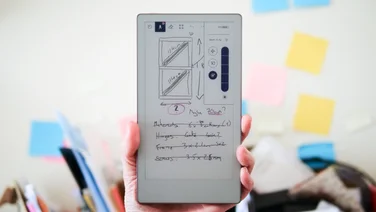To help us provide you with free impartial advice, we may earn a commission if you buy through links on our site. Learn more



The Cybook Odyssey is Bookeen’s first touchscreen eBook reader. It looks similar to the Cybook Opus, but has fewer buttons and is slightly more compact. The reader feels sturdy, with a black, brushed metal back that easily stood up to rattling around in our backpack.

Although the Odyssey is largely dependent on its touchscreen controls, it’s not been entirely stripped of traditional buttons. There’s an on switch at the bottom and buttons set into the left and right edges of the reader that allow you to turn the page if you’d rather not touch the screen with wet or greasy hands. A single button below the screen brings up a range of touch shortcuts.
Bookeen claims that the Odyssey’s High Speed Ink System (HSIS) makes it the fastest eBook reader around. However, in our slightly unscientific side-by-side page turn swipe test, the Odyssey loaded new pages fractionally slower than our reference Sony Reader. Despite this, page turns were smooth and fast enough to ensure a comfortable reading experience. The 600×800 display is the usual E Ink V220 that you’ll find on most eBook readers, but rather than the Neonode zForce infrared touchscreen system used by rivals from Kobo, Sony and Amazon, the Odyssey instead has a capacitive touchscreen. This makes little difference in practice, except that you can’t turn pages using a stylus or when wearing gloves.

The Odyssey has just 2GB of built-in storage – that’s enough to hold around 666 eBooks at a typical size of 3MB. You might eventually need extra capacity if you also want to use the Odyssey’s built-in MP3 player to listen to your audiobook collection or play the ancillary audio files that go along with some language and reference books. The reader has a microSDHC slot for this purpose, so you can add up to 32GB of additional space. Between the memory card slot and the 3.5mm headphone output is a micro USB port that allows you to connect the reader to your PC.
There’s no dedicated software for the reader, but it’s compatible with Adobe’s Digital Editions. You’ll need to either register the reader with an existing Digital Editions account or create a new one to use books that rely on this DRM system. Your Adobe authorisation is set up automatically when you create a Bookeen account either on Bookeen’s website or by connecting the reader to the internet over Wi-Fi and logging into the Bookeen store. You can also transfer non-DRM files to the eBook reader using your computer’s file manager or a third-party eBook management tool such as Calibre. The reader can also handle EPUB, PDF, HTML, FB2 and TXT document formats, plus JPEG, PNG, GIF, BMP, ICO, TIF and PSD image formats. It’s worth noting that the reader can’t reflow PDF files as you zoom into them, so you may find yourself scrolling around the page if you need to zoom in to read a PDF comfortably. This situation can be improved slightly by turning the Odyssey to read in landscape mode.
Unlike most eBook readers, the Odyssey has an accelerometer which lets it rotate the page depending on whether you’re holding it in portrait or landscape mode. Unfortunately, the reader sometimes rotated its display at random during our tests, rather than in response to how we were holding it. On one occasion the page turning function also got stuck, causing the reader to turn page after page without any interaction from us. Both these issues occurred in slightly damp conditions, so they may have been caused by moisture interfering with the touchscreen on a damp train platform.

The onscreen keyboard is a good size, making it easy to enter Wi-Fi passwords and search terms, but the default font size is too large for the screen. It’s easy to avoid a lot of unnecessary page turning simply by adjusting the font size in the reader’s settings menu, though. You can even change the font family, which is helpful for those who find it easier to read serif fonts. Like most eBook readers, you can add and edit highlights, bookmarks and notes. You can also jump between pages and pull up your eBook’s contents in a separate menu, instead of having to go back to the main contents page.
At around £130, the Odyssey is surprisingly expensive for a touchscreen eBook reader. It costs more than both the outstanding Sony Reader PRS-T1 and now budget £80 Kobo eReader Touch. Bookeen has incorporated some unique features, most notably the capacitive touchscreen and the accelerometer. However, during our testing the capacitive touchscreen didn’t make a great difference and had some possible drawbacks. If you’re looking for an EPUB reader, which lets you shop around for books, we prefer Sony’s Reader.





